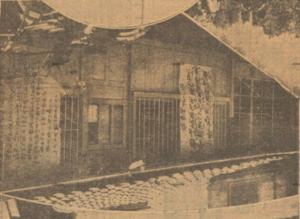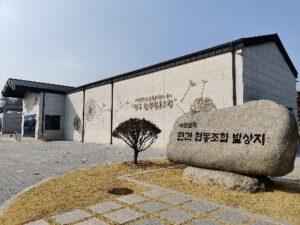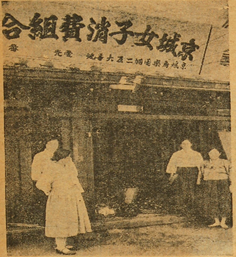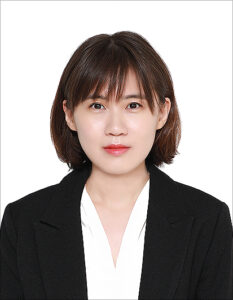Research Snapshot: The Beginning of Cooperation and Solidarity in Korea – the Cooperative movement under the Japanese colonial era
Dr Yikyung Kim
Korea has a long history of economic growth and competition. However, there is also a long and under-recognized history of cooperation and solidarity. Before cooperatives were established in the early 20th century, there were already numerous solidarity organizations across the country like dure (village-level collective labour organizations) and gye (mutual aid societies). In the early 20th century, under Japanese colonial rule, Koreans sought to solve the problems of their increasingly poor daily lives by working together, sharing the profits equitably and establishing cooperatives for local benefit.
The reason for the attention to cooperatives during the Japanese colonial period
Among the various organizations, I focused on the early history of cooperatives for three reasons. First, cooperatives served as the basic organization for improving Koreans’ quality of life and gaining basic economic rights. Second, through cooperatives farmers, labourers, housewives, students, and others began to recognize themselves as consumers as well as workers or housewives and claim consumer rights. Third, Koreans criticized the cooperative policies of the Japanese colonial authorities and attempted to operate autonomous and democratic cooperatives. Ordinary people tried to actively develop economic solidarity rather than passively accepting price-setting rights by foreign merchants under colonial rule. They sought to restore their daily lives by determining the prices of everyday goods themselves and sharing the profits.
The spread and role of cooperatives
According to my research, Koreans established at least 500 private cooperatives from 1920 to the mid-1930s to solve the problems of daily life. Koreans began establishing cooperatives with their neighbours to collectively solve economic problems by gathering grain or small amounts of money. In rural areas, where villages and markets were far apart, cooperatives were established because it was decided that it would be a loss for everyone to use the market individually. In the cities, workers collected a portion of their salaries to set up cooperatives in factories so they could buy daily necessities at low prices. This was because Koreans recognized that under colonial rule, buying necessities in markets dominated by foreign merchants was not only economically disadvantageous but also forced them to respond passively to arbitrary pricing.
What role did cooperatives play? First, they collectively purchased and sold grain, fuel, cloth, side dishes, fertilizer, farming supplies, school supplies, cosmetics, etc. that were essential to their daily lives. Secondly, cooperatives allowed Koreans to determine the prices of their goods. Third, they encouraged members to save by paying dividends based on their use of the cooperative. Fourth, they used any surplus for the community, for example, for night schools and education, hospitals, and cooperative factories. Fifth, during local disasters (floods, the season of spring poverty), they provided or donated grain to local people at low prices. Sixth, they were responsible for supporting the lives of the workers, such as providing food during trade union strikes. Seventh, farmers’ unions and cooperatives worked together to lead local economic movements. Through cooperatives, Koreans overcame exploitation by middlemen and experienced a new identity as consumers, participating in decision-making as equals.
Let’s take a look at some interesting cases.
Case 1. The Wonsan Consumer Cooperative – Combining trade unions and cooperatives

A consumer cooperative storing six months of food in case of a general strike (1929)
| The Wonsan Consumer Cooperative was founded in 1922 by workers of the Wonsan Labor Association in Hamgyeongnam-do. Wonsan was a major industrial area, transport hub, and port city, so many Koreans became workers in factories in Wonsan. They confronted the problems of labour and living issues through trade unions and cooperatives. The cooperative thoroughly investigated the economic and living conditions of the workers and supplied them with necessary goods, providing grain and daily necessities at prices 20-40% below market price. The cooperatives had about 1,800 members and provided these services to 10,000 people, including the workers’ families.
Cooperatives played a major role in the Wonsan General Strike. From January to April 1929, the Wonsan Laborer’s Association supported a strike in response to assaults and verbal abuse by Japanese supervisors and promoted a general strike in the Wonsan area to protest the unfair treatment of Korean workers. The cooperative provided food to workers participating in the strike and reassured the workers and their families by utilizing its reserves to secure more than five months of food. This played a role in preventing livelihood, conflict and violence issues that could have arisen if the strike had been prolonged. |
Case 2. The Hamchang Cooperative

Celebrating Hamchang Cooperative – Korea’s Private Cooperative History and Culture Museum
| In 1927, the Hamchang Cooperative in Gyeongsangbuk-do played an important role in spreading cooperative principles such as autonomy and democratic decision-making in Korea. A young man named Jun-han Jeon gathered members to establish a cooperative as a way to correct the high prices charged by foreign merchants and realize a self-reliant economy in Korea. In January 1927, he gathered 11 poor farmers, drew up articles of association based on cooperative principles, and began publicity and business. Within a month, the 11 members had grown to 60, and after six months, more than 420 had joined. Initially, the cooperative handled eight products such as oil and grain, but soon the number of products increased to more than 100 items, and sales continued to increase. The Hamchang Cooperative’s articles of association and methods of operation, which considered those without capital and utilized surpluses for the benefit of the community, became known as best practice through pamphlets and national lectures and influenced the spread of understanding of cooperative principles in Korea after 1927. |
Case 3. The Gyeongseong Women’s Consumer Cooperative

Gyeongseong Women’s Consumer Cooperative (1930)
| After 1929, cooperatives by women, for women, and consisting only of women became notable. There were at least 15 women-led cooperatives, through which more than 1,500 women participated in both the women’s movement and the cooperative movement. They emphasized increasing women’s economic awareness, social training and solidarity through participation in cooperatives. In 1930, in Jongno, Seoul, more than 100 women (housewives, schoolgirls, female office workers, etc.) formed the Gyeongseong Women’s Consumers’ Union in economic solidarity. In 1933, in addition to providing affordable necessities, they also attempted to establish a medical institution and donated money, grain, and clothes for flood-affected areas. |
Cooperatives in decline since 1932
The number of cooperatives founded between 1926 and 1931 grew rapidly as a result of the participation of a wide range of people. Even the Japanese authorities used cooperatives in both mainland Japan and Korea for rural development purposes, and for this reason, the colonial authorities were lenient toward accepting cooperatives even if they did not operate under the official model promoted by the colonial government (Industrial Union Ordinance). However, from 1932 onwards, their numbers dropped dramatically because the Japanese Government-General of Korea selectively suppressed cooperatives linked to farmers’ unions and ideological organizations. In addition to confiscating documents, Japanese authorities arrested cooperative officers and forced their dissolution under the pretext of association with political organizations.
Continuity of Cooperation
Participants in the cooperative movement promoted a more equal society through economic solidarity under Japanese imperialism. They attempted to build a living economy through organizations that were not national socialism or capital-driven. They had overlapping memberships and solidarity with farming, labour and women’s groups to which they belonged. At the same time, Koreans wanted to combine foreign models with their own culture to form a Korean-style cooperative economic model. These attempts and experiences by Koreans continued after liberation and are still connected today.
Author Biography

Dr Yikyung Kim is a HK research professor at Dankook University. Her primary research focuses on the history of the East Asian cooperative movement and the culture of reciprocity and solidarity, with a long-term historical perspective. Her research includes The Formation and Development of the Korean Cooperative Movement under the Japanese Colonial Rule: Focus on Concepts, Participants, and Solidarity (2022, PhD thesis, Sungkyunkwan University); “Characteristics of the Development of Korean Cooperatives under Japanese Colonial Rule”; “The Establishment and Spread of Hamchang Cooperative in Gyeongsangbuk-do under Japanese Colonial Rule”; and “A Study on the Formation of Economic Citizenship in Korea: Focusing on the Solidarity and Democracy of the Cooperative Movement under Japanese Colonial Rule”.


Comments are closed
Comments to this thread have been closed by the post author or by an administrator.